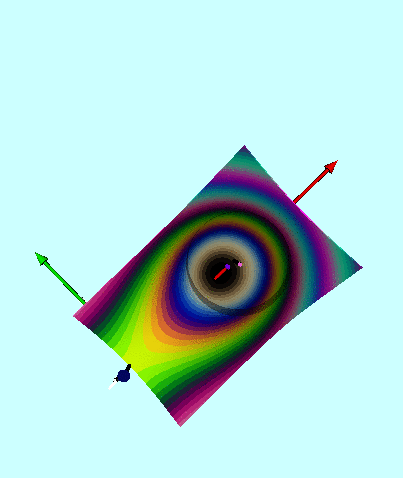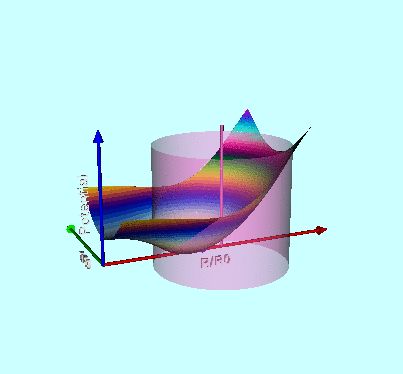Template:LSU CT99CommonTheme3B
Beginning with his integral expression for <math>~\Phi(\eta,\theta)|_\mathrm{axisym}</math>, Wong (1973) was able to complete the integrals in both coordinate directions and obtain an analytic expression for the potential both inside and outside of a uniformly charged (equivalently, uniform-density), circular torus. This is a remarkable result that has been largely unnoticed and unappreciated by the astrophysics community. We detail how he accomplished this task in an accompanying chapter titled, Wong's (1973) Analytic Potential.
If a torus has a major radius, <math>~R</math>, and cross-sectional radius, <math>~d</math>, Wong realized that every point on the surface of the torus will have the same toroidal-coordinate radius, <math>~\eta_0 = \cosh^{-1}(R/d)</math>, if the anchor ring of the selected toroidal coordinate system has a radius, <math>~a = \sqrt{R^2 - d^2}</math>. His derived expressions for the potential — one, outside, and the other, inside the torus — are:
| Exterior Solution: <math>~\eta_0 \ge \eta</math> | ||||||
|
| Interior Solution: <math>~\eta \ge \eta_0 </math> | ||||||||
The following pair of animated images result from our numerical evaluation of this pair of expressions for <math>~\Phi_\mathrm{W}</math> (including the first four, and most dominant, terms in the series summation) for the case of: (left) <math>~R/d = 3</math>, which is the aspect ratio Wong chose to illustrate in his publication; and (right) tori having a variety of different aspect ratios over the range, <math>~1.8 \le R/d \le 8</math>. |
Does this expression for the potential behave as we expect in the "thin ring" approximation? On p. 295 of Wong (1973), we find the following statement:
|
"For the case of a very thin ring (i.e., <math>~\eta_0 \rightarrow \infty</math>), the exterior solution has contributions mostly from the first term in the expansion of the series …" |
Using the notation, <math>~\Phi_\mathrm{W0}</math>, to represent the leading-order term in the expression for the exterior potential, we have (see the accompanying chapter for details),
|
<math>~\Phi_{\mathrm{W}0} (\eta,\theta)</math> |
<math>~=</math> |
<math>~-\biggl( \frac{GM}{a} \biggr) F(\cosh\eta_0)\cdot [\cosh\eta - \cos\theta]^{1 / 2} P_{-\frac{1}{2}}(\cosh\eta) </math> |
|
|
<math>~=</math> |
<math>~- \frac{2}{\pi}\biggl( \frac{GM}{a} \biggr) F(\cosh\eta_0)\cdot \biggl[ \frac{2a^2}{(\varpi + a)^2 + z^2} \biggr]^{1 / 2} K(k) \, , </math> |
where,
|
<math>~k</math> |
<math>~\equiv</math> |
<math>~ \biggl[ \frac{2}{1+\coth\eta}\biggr]^{1 / 2} = \biggl[ \frac{4a\varpi}{(\varpi + a)^2 + z^2} \biggr]^{1 / 2} \, , </math> and, |
|
<math>~F(\cosh\eta_0)</math> |
<math>~\equiv</math> |
<math>~\frac{2^{1 / 2} }{3\pi^2} \biggl[ \frac{\sinh^3\eta_0}{\cosh\eta_0}\biggr] \biggl[ Q_{+\frac{1}{2}}(\cosh \eta_0) Q_{- \frac{1}{2}}^2(\cosh \eta_0) + 3 Q_{- \frac{1}{2}}(\cosh \eta_0)~Q^2_{+ \frac{1}{2}}(\cosh \eta_0)\biggr] \, . </math> |
In our accompanying discussion we show that,
|
<math>~F(\cosh\eta_0)\biggr|_{\eta_0\rightarrow \infty}</math> |
<math>~=</math> |
<math>~\biggl\{ \frac{2^{1 / 2} }{3\pi^2} \biggl[ \frac{\sinh^3\eta_0}{\cosh\eta_0}\biggr] \biggl[ \biggl( \frac{3 \pi^2}{2} \biggr) \frac{1}{\cosh^2\eta_0} \biggr] \biggr\}_{\eta_0\rightarrow \infty} = \frac{1}{\sqrt{2}} \, . </math> |
Hence, we have,
|
<math>~\Phi_{\mathrm{W}0} (\eta,\theta)\biggr|_{\eta_0 \rightarrow \infty}</math> |
<math>~=</math> |
<math>~- \biggl[ \frac{2GM}{\pi} \biggr] \frac{K(k)}{\sqrt{(\varpi + a)^2 + z^2}} \, , </math> |
which precisely matches the above-referenced Gravitational Potential in the Thin Ring (TR) Approximation.

